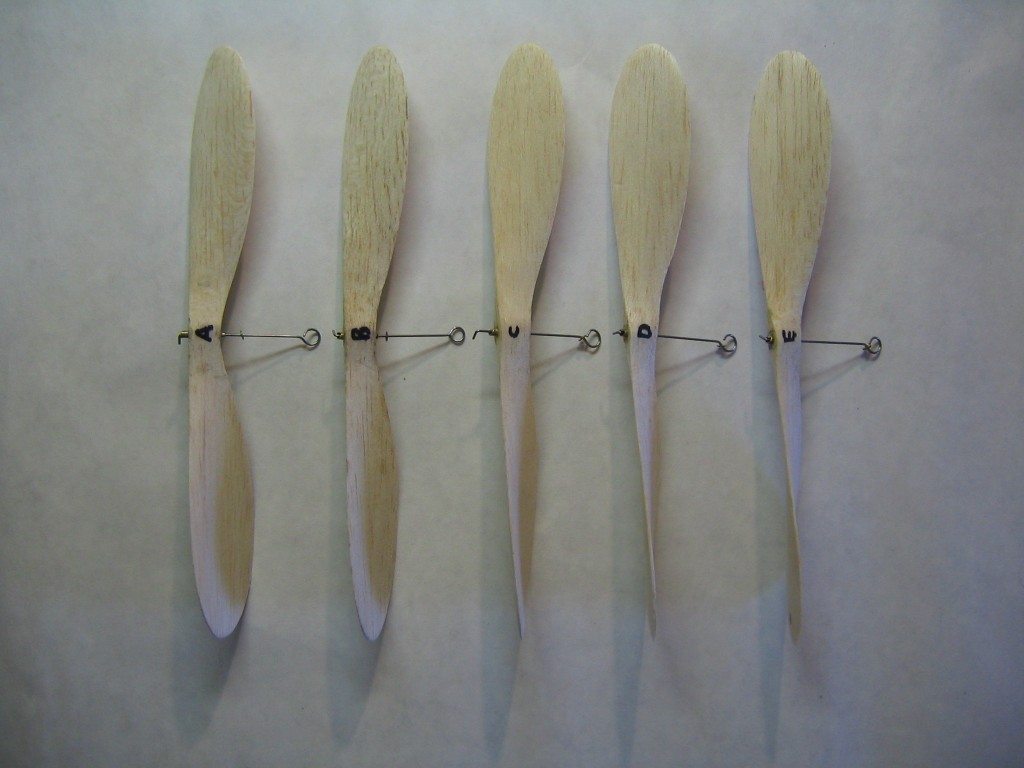The exact dimensions of the propeller block are not given on the plan or in the construction article. The dimensions of the blocks for other 8″ propellers for similar Grant designs vary slightly. The dimensions on the plan scale slightly differently, depending on what method and assumptions you use. When I first measured the half size plan using a ruler with 1/16″ divisions , I got 3/8″ for the thickness and 3/4″ for the width. I doubled those to get 3/4″ for the block thickness and 1 1/2″ for the block width. That produces a propeller with a P/D (pitch to diameter ratio) of 1.57. A more careful measurement with 1/100″ divisions and calculating width and thickness in proportion to the given 8″ diameter produces a thickness of 3/4″ and a width of 1 9/16″. That produces a P/D of 1.5. Grant in his books seems to favor 1.57.
Flight performance depends on getting a good match between airplane, motor and propeller. The motor produces torque. Each motor will produce a range of torques as it unwinds. The propeller converts torque into thrust. In level flight, thrust equals drag. One way to compare propellers is to see how much torque they require to produce level flight. The propeller that flies the plane level with the least torque allows a thinner motor, which allows more turns per inch and more total turns. It also likely has a lower revolution rate, meaning that the prop will turn for a longer time while keeping the airplane in the air. It would seem to be a fairly easy thing to compare propellers, or so I thought. 😉
The idea was to test each of several propellers, winding a standard test motor various amounts until I got a level flight, then measure the parameters for the level flight; turns in, torque in, torque out, turns out, flight time and flight diameter. All weights have been measured in the shop. The torque to fly level would be the average of the torque in and the torque out. Turns in minus turns out would count propeller revolutions, and that divided by flight time would be prop revolution rate. Pi times flight circle diameter would be distance flown and that divided by flight time would be airspeed. This last must be done in still air.
I made five propellers with different P/D; A=2.0, B=1.8, C=1.6, D=1.4 and E=1.2. Each was made using the same blade pattern, but blocks with different widths and thicknesses. The blocks were cut from the same piece of balsa. An additional complication is that these propeller blocks had different densities and the propellers had different weights; A 2.5 gm, B 1.9 gm, C 2.4 gm, D 1.4 gm, E 1.9 gm. It was necessary to calculate a wing position for each propeller to get the center of gravity in the right place. I put a pencil mark on the side of the stick for each wing position.
Still air usually occurs in the morning. I packed up my airplane, propellers, test motors, torquemeter, stopwatch, 100′ steel tape and all the other required equipment and headed over to the park.
The next complication is that the grass is wet in the morning. After a few flights, the wheels are dripping wet. What does that do to the required torque and the balance? At home, I soaked the wheels under the faucet. The water adds a gram to the weight and moves the balance point only a little.
Although the test procedure sounds easy in concept, in practice a hundred things will go wrong and there are a hundred things that you can forget. It takes about five attempts for every flight that produces a complete set of data. By the time I had got the procedure down to a standard, a wind drift had come up. It was not possible to measure the diameter of the flight circle. The best I had were a couple flights where the plane had come down after a half circle and I taped off the distance from the launch point. In drift, circling had to be judged from the direction the stick was pointing. Eventually the plane was drifting all the way across the field into the trees on the far side. Once the drift changed direction and the plane circled among a half dozen trees behind me.
Later I found that more turns were required to get a level flight with the same prop. Was this due to the water? No, the wheels had been wet almost from the start. I found that fresh lube on the motor brought the required turns back down. The lube dries out in the morning sun. Keep that in mind when flying in a contest.
In the end, what I had were some pretty good tests on prop B. It flew a level circle in 19 seconds with 1,180 turns on the 18″ loop of 1/8″ rubber. With the same motor and turns, prop A turned about a quarter circle in 7 seconds and prop C turned about a half circle in 11 seconds. I decided that was enough, I would use prop B for my postal contest flights. Engineering testing is much simpler than scientific investigation. Time was running out and I had to use any time with no wind on a much larger field to get the flight times I was hoping for.
Gary Hinze
